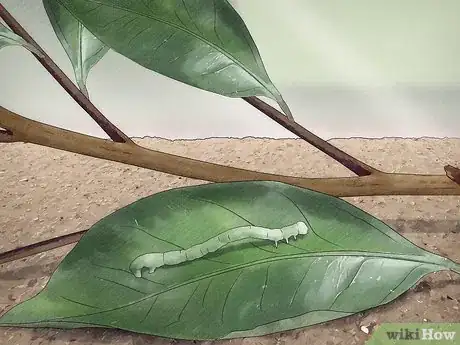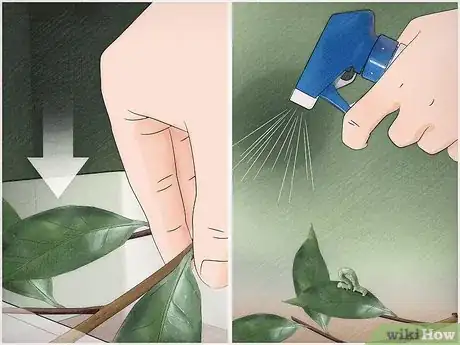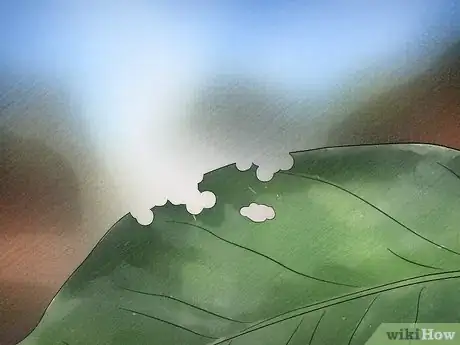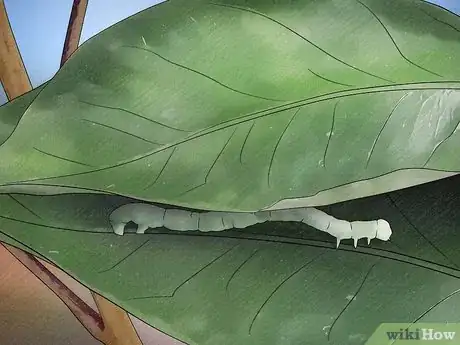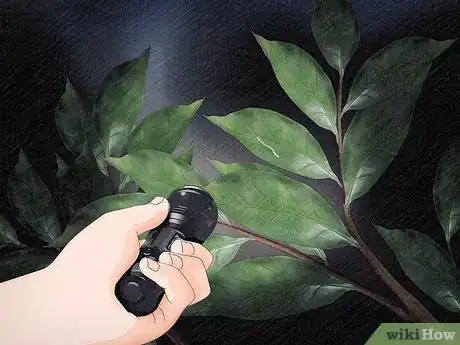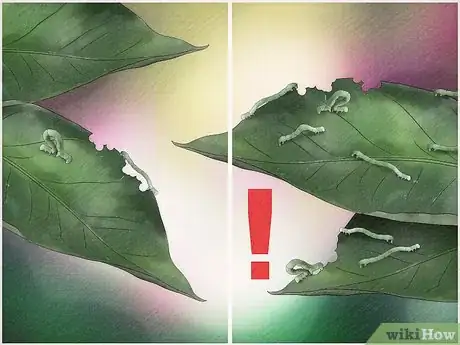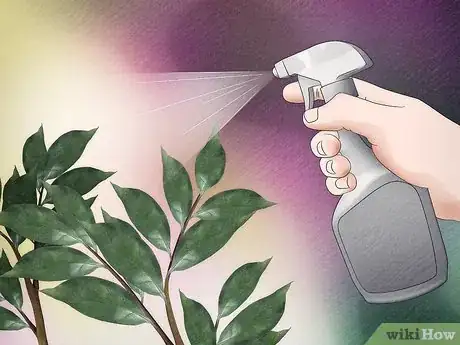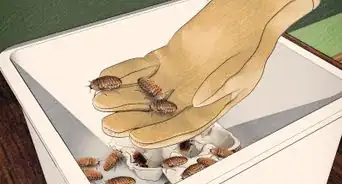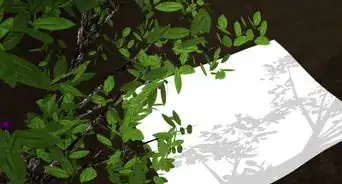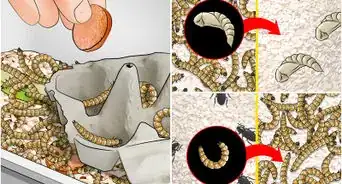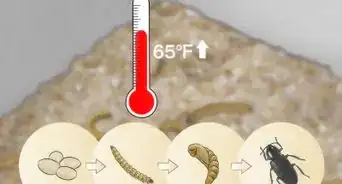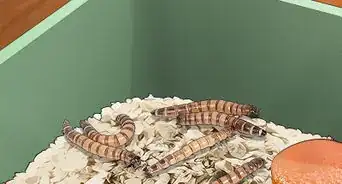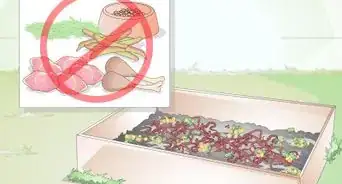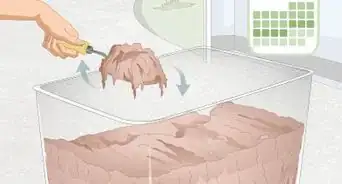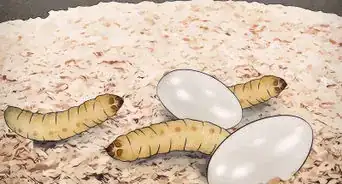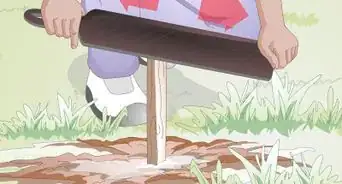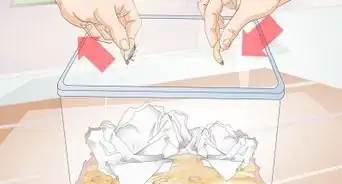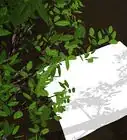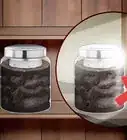This article was co-authored by wikiHow Staff. Our trained team of editors and researchers validate articles for accuracy and comprehensiveness. wikiHow's Content Management Team carefully monitors the work from our editorial staff to ensure that each article is backed by trusted research and meets our high quality standards.
There are 7 references cited in this article, which can be found at the bottom of the page.
wikiHow marks an article as reader-approved once it receives enough positive feedback. This article received 14 testimonials and 89% of readers who voted found it helpful, earning it our reader-approved status.
This article has been viewed 228,141 times.
Learn more...
Inchworms are a pretty low-maintenance pet that are great for young children. You simply keep them in a suitable habitat, feed them leaves, and let them go when they turn into moths. Knowing when and where to look for them will help you find one early so you can enjoy them for as long as possible. However, inchworms can be pretty devastating to plant life in large numbers, so if it looks like you have a whole lot of them in your garden or yard, there are a couple easy steps you can take to reduce their numbers.
Steps
Caring for Pet Inchworms
-
1Prepare a habitat. Purchase a terrarium with a ventilated top from a pet store. Or, make your own habitat with a lidded container made of glass or plastic. Poke several small holes through the lid with a thin nail or similar tool (no thicker than the tip of a pencil) so air gets in, but the worm doesn’t get out. Line the bottom with about an inch of dirt or wood shavings.[1]
- Inchworms aren’t that strong, so you can use aluminum foil, plastic wrap, or something similar as a lid so poking holes is easier.
- Pick a spot for it on a windowsill or near a window so your inchworm gets plenty of sunlight.
-
2Hunt for them in spring. Be aware that inchworms have pretty short lifespans. Expect them to cocoon and turn into moths toward the end of summer. So, to spend as much time with them as possible, look for them soon after they first hatch from their eggs in spring.[2]Advertisement
-
3Include leaves and stems in your habitat. There are thousands of different types of inchworms, and each one eats different foods.[5] So when you find one for your habitat, also trim some of the leaves and pieces of the stem from the tree or plant that you find them on. Add these to the habitat so your inchworm has something to eat.[6]
- Remember which tree or plant you found them on, or at least what type it is.
- This way you can collect more leaves if needed to keep your inchworm fed.
-
4Check your inchworm daily. Check the leaves and stem pieces that you added to make sure it has enough food. Once they look like they’re beginning to rot, clean out the habitat and collect more leaves, stems, and dirt from outside. Spray a mist of water inside every so often so they stay hydrated. Also, keep fresh air circulating in the room by keeping the window open.[7]
- If it’s too cold or hot outside to keep your window, at least crack it open a few times throughout the day.
- Eventually they will cocoon themselves and then turn into moths. Keep their area moist and with sufficient light; they will turn into moths in about a few weeks. When that happens, you need to let the moths go outside. Simply unseal the container in the area that you originally found the inchworm.
Finding Inchworms
-
1Look for signs of feeding. Check leaves of trees and plants for lots of little holes, which show where inchworms have been munching. Also look for leaves that have been stripped totally clean. They’ve probably moved on from that leaf by now, but this shows they’re in the immediate area and will help narrow down your search.[8]
- Since you’re probably searching during the spring, plants and trees may still be blossoming. If so, you can also check the buds for signs of munching, since inchworms will eat those, too.[9]
-
2Search in shaded areas. Lots of animals feed on inchworms, so expect them to hide. Check the underside of leaves to see if any are clinging directly to them.[10] Also check for them in midair, since they spin webs just like spiders, and may be dangling well below leaves and branches.[11]
- You may also find them on the ground, but this usually happens when they’ve fully matured and are ready to cocoon underground. So if you’re looking for inchworms to keep as pets, these are no good, since they’re ready to change into moths.
-
3Check areas with crowded vegetation. When an inchworm is done feeding on a leaf or plant, it spins a web long enough for it to swing to the next, like a rope.[12] So look where the leaf cover is pretty dense, where they can do this more easily. Also, since each type of inchworm feeds on different types of food, look in areas with lots of the same type of plant or tree.[13]
- If you’re looking in trees, also check the plants growing around its base. The inchworms may have worked their way down to them.[14]
-
4Look at night, too. Start searching in the daytime, since it’s easier to spot where they’re feeding in natural daylight. Some inchworms feed during the day, so you may find them right away. If not, this particular type may be nocturnal, so grab a flashlight and double-check after dark.[15]
Taking Care of Infestations
-
1Identify signs of damage. Inchworms are small and may feed at night, so recognize other signs of infestation, since they may stay out of sight. Look for little holes in the leaves of your trees, bushes, and garden plants. The more you see, the more likely it is that you have a large population of inchworms.[16]
- Inchworms are commonly attracted to elm, fir, hickory, maple, oak, and pine trees.
- Since they also eat fruit, they can often be found in berry bushes and fruit trees.[17]
-
2Ask yourself if it’s really a problem. Before you go through the trouble of trying to solve it, decide if it’s really worth the effort. Consider where you found evidence of inchworms, and how pervasive it is. For instance:
- Individual inchworms don’t eat much, so if you only find sporadic leaves that seem to be eaten, the population is probably small.[18]
- If the leaves in question are confined to trees, the trees may offer enough food to support the population without widespread damage.[19]
- Smaller plant life, like garden plants and bushes, are more at risk, since they offer less material for the inchworms to feed on.
-
3Let predators do the work. Lots of small animals feed on inchworms, so encourage their presence. Birds are perhaps the easiest (and preferable) to attract, so hang bird houses and feeders around the affected area. In addition to birds, inchworms are also prey to:[20]
- Lizards
- Yellow jackets
- Wasps
-
4Treat the affected area with pest control. Spray the leaves or the worms directly with insecticides, which are an effective means of dealing with inchworms. Or, if you’re worried about toxins, use a non-toxic remedy. Instead of traditional chemical poison, use a natural pathogen, like bacillus thuringiensis, which you can find online or in garden stores.[21]
- Bacillus thuringiensis only affects insects, making it an ideal solution for gardens, fruit trees, berry bushes, or other crops.
- Treat the area again next spring to eliminate any eggs that may have been fertilized during your last infestation. Different types of inchworm reproduce at different times, but all types hatch in spring.[22]
Community Q&A
-
QuestionWhat if I cannot find a good place?
 Community AnswerKeep the inch worm where you know nothing will happen to him/her. I keep my inch worm in my room. When I'm at school I put him on my window sill so he can get sunlight, and I always check if he needs new leaves before I leave.
Community AnswerKeep the inch worm where you know nothing will happen to him/her. I keep my inch worm in my room. When I'm at school I put him on my window sill so he can get sunlight, and I always check if he needs new leaves before I leave. -
QuestionDo inchworms like water?
 Community AnswerYes, but do not just put water in the cup. It will drown them. They get their water from the leaves they eat. If they are not eating the leaves, make sure you put in leaves that it will eat, to get the needed nourishment.
Community AnswerYes, but do not just put water in the cup. It will drown them. They get their water from the leaves they eat. If they are not eating the leaves, make sure you put in leaves that it will eat, to get the needed nourishment. -
QuestionCan you touch your inchworm?
 Community AnswerAs long as you're gentle, go for it.
Community AnswerAs long as you're gentle, go for it.
Warnings
- If you leave the container inside your house, the inchworms could get loose.⧼thumbs_response⧽
- Be warned that inchworms are very easy to lose.⧼thumbs_response⧽
References
- ↑ http://animals.mom.me/raise-inchworm-9342.html
- ↑ http://animals.mom.me/raise-inchworm-9342.html
- ↑ https://www.bayeradvanced.com/articles/signs-of-common-rose-pests
- ↑ http://animals.mom.me/inchworm-identification-8927.html
- ↑ http://animals.mom.me/inchworms-kids-8744.html
- ↑ http://animals.mom.me/raise-inchworm-9342.html
- ↑ http://animals.mom.me/raise-inchworm-9342.html
- ↑ http://animals.mom.me/inchworms-kids-8744.html
- ↑ https://www.bayeradvanced.com/articles/signs-of-common-rose-pests
- ↑ http://animals.mom.me/lifespan-inchworm-9145.html
- ↑ http://www.nytimes.com/interactive/2016/03/25/science/spring-science.html
- ↑ http://www.nytimes.com/interactive/2016/03/25/science/spring-science.html
- ↑ http://animals.mom.me/inchworms-kids-8744.html
- ↑ https://www.bayeradvanced.com/articles/signs-of-common-rose-pests
- ↑ http://animals.mom.me/inchworms-kids-8744.html
- ↑ http://animals.mom.me/inchworm-identification-8927.html
- ↑ http://animals.mom.me/inchworms-kids-8744.html
- ↑ http://animals.mom.me/inchworms-kids-8744.html
- ↑ http://animals.mom.me/inchworm-identification-8927.html
- ↑ http://www.allaboutworms.com/how-to-get-rid-of-inchworms
- ↑ http://www.allaboutworms.com/how-to-get-rid-of-inchworms
- ↑ http://animals.mom.me/lifespan-inchworm-9145.html
About This Article
To care for inchworms, line the bottom of a glass or plastic container with an inch of dirt or wooden shavings, and poke several small holes in the lid for ventilation. Then, add pieces of leaves and stems to the container for the worms to eat, making sure to replace them if they start rotting. Additionally, spray the habitat habitat regularly with water to hydrate your worms, and open the window several times a day to let in fresh air. For tips on how to find inchworms, keep reading!


